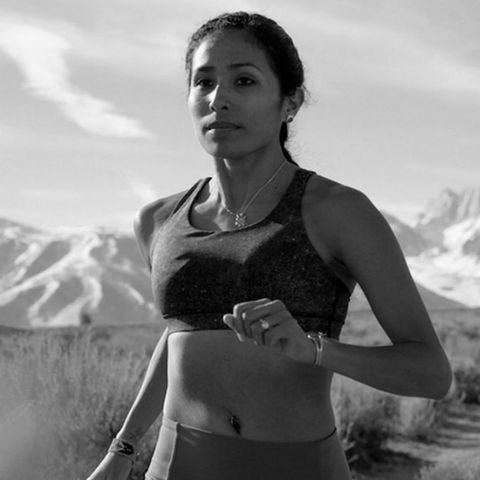”My name is Jordan Marie Brings Three White Horses Daniel. I am Kul Wicasa Lakota and a citizen of Kul Wicasa Oyate/Lower Brule Reservation in South Dakota. I am also Diné (Navajo). I am passionate about many things. However, I want to connect two of those passions that really make life worthwhile: running and activism.I was born to run, but I rejected it for quite some time. My Lala (grandfather) Nyal Brings was a long-distance runner for the University of South Dakota and was inducted into the USD Hall of Fame for his running accomplishments. Friendly rivals, Lala Billy Mills and Lala Nyal competed in the mile a few times, with Lala Nyal taking a victory over Billy. In the 1964 Tokyo Olympics, Lala Billy would go on to win a gold medal in the 10K. My Lala Nyal took me on my first run and it ended with a half-mile uphill that ultimately led me to not like running. I didn't find it fun at all. My Ina (mother) was a sprinter and my Lala was her coach, with a sure plan to get her to the 1988 Olympic Trials. However, her path led her to become an incredible pediatric, dialysis and oncology nurse. My Até (dad) really helped me develop a mental toughness for running — something I'll never forget.I grew from tolerating running to really falling in love with the sport. I started with the 5K and 10K my freshman and sophomore years of college, then moved down to shorter distances. However, after college, I moved back to longer distances, then half marathons and eventually marathons. After college, Lala Billy's organization, Running Strong for American Indian Youth, had asked me to join their team for the 2016 Boston Marathon. At the time, I was working with tribes to implement programs, some specifically for Native youth in Washington D.C., and I was glad to help Running Strong raise funds. I suffered an injury while preparing for that marathon but somehow got myself to the starting line in Hopkinton, Massachusetts.My coach got me into the first wave and corral, so to experience that while fan-girling over my idols gave me the adrenaline to run through the pain. When the gun went off, all I could think about was my Lala Nyal, my Ina, Lala Billy and my entire tiospaye (extended family) back in Lower Brule and Indian Country. I was running Boston, something I never would've dreamed possible. Alongside me, others were running to get a best time or running for a cause, all while running with other Indigenous relatives. I had a lot to reflect on. I got to the finish, feeling happy and emotional. I was in pain, but the joy I felt upon completing that race wasn't for me, it was for Indian Country. The possibilities for Indigenous Peoples are endless and to share that with everyone was beautiful.That experience led me to use running as a way to change the narrative around how people see or think about Indigenous Peoples. The protests in Standing Rock over the Dakota Access Pipeline really inspired me. While I was working full-time and training, I was also organizing events, rallies and marches to raise awareness about environmental, social and economic issues where running could serve as another platform. The Standing Rock youth who ran 2,200 miles from North Dakota to D.C. to hand deliver a petition opposing the Dakota Access Pipeline to protect water — our first medicine (mni wiconi translates to water is life) — was a great motivator for me, and an example of how I thought I could connect running with activism. https://www.jordanmariedaniel.com
show less


Comments